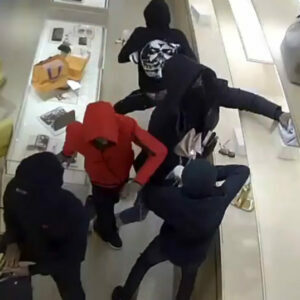This is crazy,” said Noel Escobar as he pulled out his mobile phone and started filming thieves ransacking the Nordstrom store at Topanga Mall in Los Angeles.
His video showed a gang in masks and hoodies breaking open glass displays and grabbing clothes, purses and luxury goods. The band of thieves barged out of mall doors while a security guard watched nearby.
“This is nuts,” Escobar muttered as they fled.
The scene is hardly unique in America in 2023. Near Charlotte, N.C., hammer-wielding thugs recently bashed in a Kohl’s jewelry display in broad daylight. In Glendale, Calif., 30 robbers committed a “flash mob burglary” at a Yves Saint Laurent store, stealing $300,000 in merchandise.
All told, shoplifting mobs and smash-and-grab robbers are costing retailers $100 billion in losses in what law enforcement calls organized retail crime (ORC). Shoplifting today isn’t teenagers sticking a few beers in their jackets or stealing party supplies at the Food King. Instead, many robberies are executed by some of the most dangerous criminal cartels in the world. The profits from retail theft in New York and Chicago help fund drugs, prostitution, and human trafficking in Mexico and Central America.
And American shoppers may unknowingly be contributing to the cartels’ profits.
“These folks that are going from store to store and state to state with lists and compiling all the merchandise and warehouses cleaning it and selling it on online marketplaces,” said Alysa Erichs with United to Safeguard America from Illegal Trade (USA-IT), a public-private partnership fighting the sale of counterfeit, illicit and stolen goods.
“Like, it’s legitimate street gangs,” added Erichs, a former executive associate director at Homeland Security Investigations. “Depending on where you are, there are different gang names for different areas and regions. … We’re seeing that gangs are recruiting juveniles because it’s basically a revolving door when they get caught because they’re below adult age. If they get caught, they have more sources that are out there.”
There is also the potential for human trafficking. Erich says some ORC suspects are people who were smuggled across the border. “They’re finding it more easy to pay off their debt doing ORC-related activity as opposed to smuggling drugs.”
The National Retail Federation agrees. Its 2021 National Retail Security Survey reported retailers experienced a 26.5 percent increase in ORC from 2020 to 2021 — including ORC-related violence and aggression.
The effect is being felt from shelves of deodorant and razor blades all the way to corporate board rooms.
Dick’s Sporting Goods saw profits plunge 23 percent in the second quarter because of organized retail crime. Nordstrom closed its flagship store in San Francisco in August, citing declining sales, with employees blaming the surge in crime.
Most disturbing, law enforcement says, is the violence that has become more common in these crimes. Target executives reported a 120 percent increase in violent theft at its stores this year. Shoplifting teens tend to run away when confronted. Gang members fight back; at least two store employees have been killed.
Gary Rasor, an 83-year-old great-grandfather, died last year trying to stop a suspect at a North Carolina Home Depot. Another Home Depot employee, this time in California, was shot to death while attempting to stop a female theft suspect from leaving with what was believed to be a phone charger. In both cases, police eventually captured the suspects.
Retailers say the surge in crime is hurting their business on both sides of the checkout counter. In addition to losing merchandise, they are finding it more difficult to fill their industry’s more than 900,000 job openings.
“Stores that experience frequent, visible ORC incidents, particularly those that involve threats or assault against retail workers, may experience reduced morale and higher staff turnover,” the retail federation told Congress in June. “Younger workers and their parents cite the ORC they see on the news as a primary concern about the relative safety of jobs in retail stores or shopping centers.”
The National Retail Federation supports bipartisan legislation called the “Combating Organized Retail Crime Act of 2023” to strengthen laws against organized retail crime.
“Retail crime was a dirty secret for a while,” said Carol Spieckerman, a retail consultant and adviser. “Now retailers are quantifying the impact. … Retailers are ready to invest in new technologies that take mitigation to the next level. The digital rethinking of physical retail is accelerating, and retailers are waking up to the reality that these efforts can’t be isolated to upside opportunities like retail media. Retailers will have to invest in crime-thwarting technology to maintain profitability.”
Retailers are also beginning to transform their store interiors. That includes adding thick plastic barriers or security cages in front of some products (also known as product hardening) and more high-resolution video cameras. Some mall stores limit the number of customers allowed inside the shopping area. Supermarkets and big-box stores also hire off-duty police officers to serve as armed security guards.
That is not always enough, according to analysts like Spieckerman. “Local police often don’t have the bandwidth to effectively address retail crime. In smaller communities, a single big-box retailer or a handful of dollar stores can overwhelm law enforcement.”
Small businesses can’t always make the same changes or absorb inventory losses the same as big-box stores. Some owners end up either shutting down, moving, or raising prices.
Congress recently passed the INFORM Consumers Act, a law meant to require that online marketplaces verify certain information, including bank account and tax IDs from larger third-party sellers. While Spieckerman called it a step in the right direction, she noted, “It won’t be an instant fix. It will take a while for the deterrent effect to kick in.”

